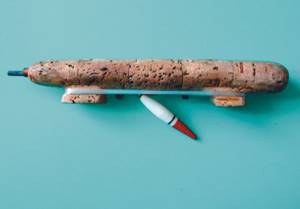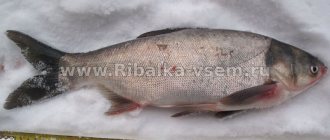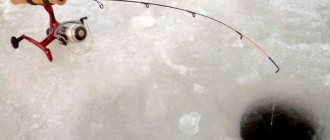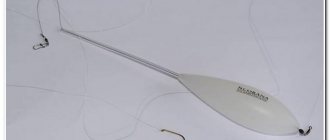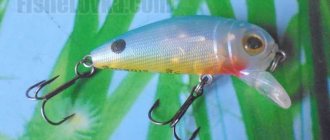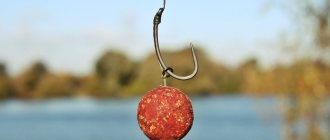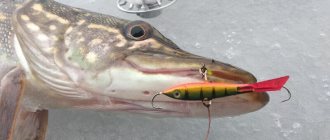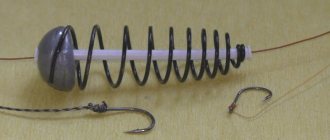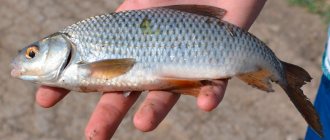The arrival of winter is not a reason to give up your favorite activity - fishing. Moreover, at this time you can catch not only small fish, but also quite large ones, for example, ide. For fishing to be successful, it is important to know some of how ide fishing works in winter.
Rice. 1. Ide caught in winter on the Ob
.
We recommend watching a very useful video about catching ide in winter:
Necessary gear
The ide has sufficient strength, so the tackle chosen is strong. However, if they are too rough, it may spook the fish. Therefore, when choosing the right ones, you need to be able to find a compromise.
Expert opinion
Valery Andreevich Sizov
Professional fisherman with 35 years of experience
It is recommended to choose a fishing line of 0.1-0.2 mm. The hook is taken depending on the expected size of the fish caught. For example, for small specimens, No. 3 and 4 are suitable. For large fish, No. 5.
Is winter ide invulnerable?
Photo by the author
In reservoirs rarely visited by fishermen, ide reaches a weight of 8 kg. Usually this beautiful silvery fish with red fins is caught in the spring, during the pre-spawning run. But catching ide is no less exciting during the freeze-up season, especially on the last ice. However, it must be admitted that ide is caught off the ice mainly by accident, when catching other fish.
In central Russia, at the end of March and beginning of April, ides begin to rise up the rivers simultaneously with bream and roach. Of course, fishing for ide from ice can be exciting and rewarding only if you know well in which bodies of water and how densely this fish lives. First of all, you should look for ide in holes and deep places with weak currents. In dammed rivers, the ide sticks to the underwater edges while moving, where it finds enough food. One day at the end of March I decided to spend a few days on the Volga Nerl in the hope of one last good ice fishing. On the first day, as soon as it cleared, I settled on a well-known sandy edge. The river at this point made a sharp bend and the fish lingered here in the quiet water to feed. Usually the edge gave me 3-4 kg of selected roach in the morning, although sometimes I also came across bream. I always fished on this edge with bait.
This time the roach took it with long pauses. And if a small one came up, the hooking was often in vain. A situation like this can make any angler lose patience. So I didn’t even attach any importance to the fact that with each bite I was hooking more sharply and irritably. And when the nod suddenly bent sharply, he hooked it so that the fishing line with a diameter of 0.10 mm broke off like a rotten thread. I take out a spare fishing rod and continue fishing with a jig, placing a couple of burdock moth larvae and one large bloodworm on the hook. Again a similar bite and I take out from the hole a weighty ide with small silvery scales shimmering with gold. A real handsome man! It probably doesn’t reach a kilogram, but I get a fair dose of adrenaline. That morning, literally one by one, I caught a couple more good ides.
HABITAT
In the middle of winter, ide is passive, noticeably reviving after the last ice. At this time, river ides leave deep holes, where they coexisted with schools of bream and large perches, and go to relatively shallow places. Yazi, living in reservoirs and vast lakes, also make local migrations, entering the mouths of tributaries in order to immediately move to spawning grounds after ice drift.
Success is more likely to occur if you search without staying in one place. With such fishing tactics, you need not only to have good physical training, but it is also important, when you find a school of fattening ide, to offer the fish a catchable bait and decide on the speed of the retrieve.
Under the ice, live food leads a sedentary lifestyle. Therefore, high-speed wiring of the jig will be appropriate only in rare cases. Yazi, like most other carp fish, respond more readily to slow retrieval with a minimum amplitude of oscillation of the jig. In the case when zooplankton is located in the water column, it is necessary to determine at what level the ides are kept using the “poke and poke” method. This can be 1.5-2 m from the bottom, or at half-water. Of course, it is not only food objects that force this fish to rise above the bottom. The cause may also be sudden changes in atmospheric pressure and other weather phenomena.
In general, it must be said that ulcer flocks (usually no more than 5 individuals) avoid fast currents after a harsh winter. In March, the most promising areas may be the mouths of small rivers and streams, underwater spits and edges with a sandy-muddy bottom and a gentle current. Like perches, ides often visit snags, where there is plenty of food for them. Large ides weighing 1.5-2 kg, unlike roaches, stay mostly alone and only form small groups just before spawning.
FEEDING
When fishing with a float rod, an angler rarely does without using dry bait, branded or homemade. In principle, any bait intended for white fish can be quite suitable for ide. As for other carp fish, it is a good idea to add 20-30 g of small food bloodworms mixed with bottom debris to each feeder before lowering it to the bottom, which is not eaten by the fish, but retains the smell of bloodworms for a long time. Some of the larvae must be crushed, and the other part must be left alive. Before filling the feeder, I always moisten the dry mixture with water from the hole. This must be done in all cases, even if there is no current under the ice or it is very weak.
|
It is best to feed several holes at once, and then fish them one by one. We should not forget that the ide is a very cautious fish, so experienced fishermen, after landing a large trophy, give the hole a “rest” so that the school of ide can calm down. Before starting fishing, it is enough to drop up to 200 g of moistened food mixture with small bloodworms into each hole. Where there is shallow depth and no current, it can be useful not to use a feeder, but simply pour a handful of dry mixture into the hole from time to time, as is done when catching bleak. Particles of food that slowly sink to the bottom attract fish that are located near the hole to a greater extent. The same feeding technique also works well when the bite fades - particles scattered in the water column spread their smell far.
Ide is caught using the same gear as roach - a winter float rod or one equipped with a nod and a jig. Large bloodworms, small dung worms or pieces of them are usually used as bait.
WITH FLOAT
A “filly” is best suited as a fishing rod for float tackle. The handle of the fishing rod is made of cork or hard foam. The first option is preferable. The whip is usually made of polycarbonate. When assembled, this fishing rod is quite compact (photo 1). The fishing line is set with a diameter of 0.12-0.15 mm, depending on the expected size of the fish, hook for attaching bloodworms No. 15-18; for worms and bark beetles – No. 9-12 according to the international classification. The equipment looks like this: at the end of the main line there is a sinker in the form of a shot, above it a leash 10-15 cm long with a hook. In no case should the leash be stronger than the main line. Particular attention should be paid to the strength of the knots - this is perhaps the most vulnerable point in equipment designed for catching ide.
At above-zero air temperatures, when the holes do not freeze and when you are sure that ides are suitable for bait, the float does not have to be immersed 2-3 cm below the surface of the water in the hole. In this case, it is not submerged and will show a bite in the same way as when fishing with summer float tackle. The ide bite is decisive; when fished, it exhibits more violent resistance than roach or bream.
|
Taking this feature into account, fishing from ice using a fishing rod equipped with guide rings and a spinning reel is widespread among Western advanced fishermen. Your humble servant also acquired such equipment. However, in Russia such an innovation is still the lot of a few winter fishermen. At the same time, the presence of a friction brake and the ability to easily drop the line from the spool and quickly reel it in makes a spinning reel very appropriate, especially if you are going after a large ide.
The equipment for fishing with spinning gear differs only in that instead of a float with a blind mount, a sliding float is installed. I use homemade floats made of hard, finely porous foam. The diameter of the tulip through which the main line passes is 1.5-2 mm, so that the stopper easily passes through the guide rings when winding the line. I knit the stopper from fishing line at home and do not tighten it too tightly, leaving the ends 1 cm for easy grip with my fingers. Below the stopper I place a short cambric or bead.
At the fishing site, having fed the hole and fixed the depth, I tighten the locking knot more tightly so that it does not move during the process of landing the fish. With proper installation of the gear, problems with the stopper, as a rule, do not arise. Tying it on a fishing line while fishing is not the best thing to do. With a sliding float and an inertia-free open reel, it is best to fish during the thaw.
WITH A NOD AND A JIG
A float rod, as you know, is a stationary tackle. But you can hunt for ide with other gear, moving around a body of water and searching with a fishing rod equipped with a sensitive nod and a jig. Some anglers use a steel spring nod. I prefer to fish with cone-shaped nods made from a lavsan plate. As a rule, spring ide takes from the bottom, less often in the water column. The shape and color of the jig do not play a special role. The main thing is that the bait is fresh. Usually, when catching roaches, I use jigs of black or dark gray (matte) color, but I noticed that large ide are more willing to bite on light-colored jigs - with a yellow brass crown or made of bronze.
Good results are obtained from jigs of green, red and brown colors, as well as variegated ones. In shape they can be uralks, lentils, oats, ants, nymphs. Playing with a jig is somewhat similar to the technique of catching chub. The jig with the nozzle should be lowered slowly, with rocking, then smoothly raised above the bottom. After a short pause, lower the bait again, giving it the movement of slowly falling food. Other wiring options may also be effective. For example, the next one. On the way to falling to the bottom, the jig is stopped from time to time, and then, slightly slowing down its movement, it is set to oscillate with a small amplitude. After the bait falls to the bottom, pause for 2-3 seconds. Then, shaking, slowly lift. The bite usually occurs at the moment when the bait turns on the bottom, imitating the movements of the larva, or breaks away from it.
ATTACHMENTS
Although many experts classify ide as a non-predatory fish, it is more accurate to talk about its omnivorous nature. At the same time, the diet of roaches (individuals up to 500 g) and large ides can vary significantly. For the former, these are various larvae, small mollusks, and worms. For the latter, mainly forage fish: kingfish, bitterling, fingerlings of bleak, roach and other white fish. Depending on the nutritional characteristics, certain attachments are used. At the same time, few people know that ide is especially partial to the larvae of bark beetles, which lay eggs under the bark of stumps, fallen or dried-out trees. The larvae are legless, have a white or yellowish cylindrical, sometimes flattened body. As they develop, they make numerous passages both in the bark and in the wood.
Bark beetles are obtained using a hatchet under the bark in forest clearings, as well as when preparing firewood. For bait, it is better to select small and medium-sized larvae. They are usually stored in boxes with holes for ventilation, into which a little sawdust or wood dust is poured. In winter, frozen bark beetles are best placed on a balcony or in a cold hallway. Once in the warmth, the larvae come to life and begin to crawl. The best bait is considered to be white larvae of the longhorned beetle, which live mainly in the bark and wood of pine trees. The bark beetle is placed on a light hook No. 10-17 under the head, sometimes like a worm. First, they pierce the hard head with a sting, and then insert the hook into the body of the larva so that it is completely hidden in it, along with a ring or spatula. When fishing with a jig, use the smallest larvae or pieces of large ones.
On the last ice I came across quite weighty ides on small yellow-white perch spoons. In clear weather, the bite is better on dark-colored baits.
Vladimir Kazantsev March 20, 2013 at 00:00
Bait
An excellent bait for biting ide would be raisins. It can be used as stand-alone bait or in tandem with peas, corn, worms, etc. Before catching ide raisins, you need to fill it with water and put it in the refrigerator overnight. In the morning the bait will be ready.
You can also catch ide with a jig. Both small and large individuals go for it. Can be used:
- Uralka;
- ants;
- devils.
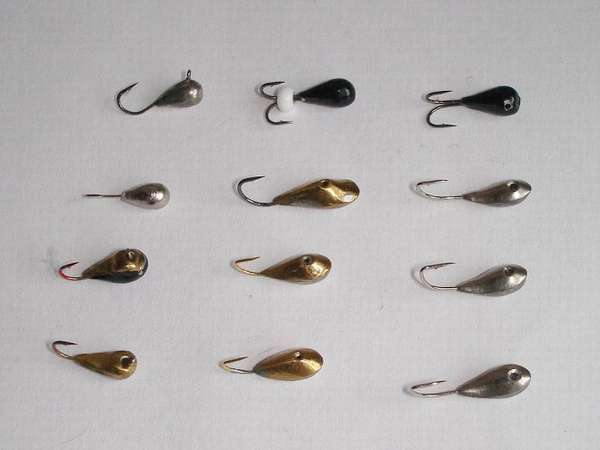
Rice. 2. The color of the jig depends on the weather. In clear weather it is better to use copper and brass, and in rainy weather - silver.
When catching ide with a jig, it is recommended to additionally add another bait. For example, worms or bark beetles.
You can also catch ide with light-colored spinners. They should be approximately the same size as for perch (No. 1-3), but thinner, without tin and at least 3 mm thick.
Features of fishing for ide in winter
Often autumn fishing for ide is so exciting and vibrant that for a long time the fisherman, especially a beginner, remembers the moments of violent cascades of splashes and the sight of the shining flesh of an ide tearing on the fishing line. It’s as if gold is burning in the Volga water, and then this “gold” beats furiously in a cage tied to the side of the boat.

The ide is extremely strong, and most importantly, stubborn and capable of jumping out of a poorly tied cage in a high pirouette. Usually such successful fishing happens in the Volga riverbed, for “ringing” and other donkeys, of which there have become quite a lot since the advent of the feeder. It would seem that what changed with the fact that the water became transparent “glass” when the first ice came: the same Volga, the same places, the same depths, the sun shines just as it was in the quiet days of the “Indian summer”, but where did the ide go?
With the arrival of the first ice, everything changes in the water element. There is less and less light and oxygen under the ice. Therefore, the places where fish stay and the depths where you can catch ide are changing, now with winter gear. And the ide’s feeding trips are becoming less and less common, like most cyprinids, because in ice-cold water it needs less and less food. This is due to the natural slowdown of all its vital functions. The period of first ice is often the best time for winter ide fishing. These are places in the channels of the lower Volga, where there is a lot of vegetation that has not yet fallen to the bottom. The ide stayed there in the summer and “out of habit” stays there in the first ice. Where should he go? Here, it will probably be possible to find it during real winter, only now less and less often and, more likely, during persistent mild thaws. It would seem, what difference does it make to the fish whether the frost is fierce over the ice or the damp snow is quietly falling? But this is for us. Fish reacts sensitively to all the seemingly slightest changes in the weather, and therefore in pressure.
In the wide channel of the middle Volga, the ide bite sometimes stops completely for the whole winter. Only by chance does it come across together with bream and other numerous brethren from the carp family. But this is not the rule either. One local old man said: “As soon as I break a lane in the first ice, I spend the whole winter renewing it, and from it, no, no, I’ll pull the ide out...” Like this. And no wonder. If he always has crusts of bread floating in this lane, and at the bottom there is always some kind of village food. Grandfather did not spoil the ides with porridge so that it would not rot to no avail and would not drive away the fish with a bad smell. He fed me more grains and cruelly chopped worms. And the crusts of bread settle in pieces and float with the flow. Below there is a flock of ides, no, no, and they will be drawn to the lane by the smell of fresh village bread. This is the simplest surface bait.
Ides are often caught together with bream, but if the bream mainly takes from the bottom, then the ide can take the bait at higher water levels. Such outings occur especially often closer to spring. And on the so-called last ice, ides are often taken correctly, and already with summer fury and strength. And this period of March-April can be called the best in catching winter ide. He is already preparing for spawning, which he will be one of the first among his brothers - silver roach and bream.
Tactics
Step by step steps:
- Choose a suitable location.
- Make a hole.
- Add complementary foods.
- While waiting for the fish to come to it, make several other holes nearby and try to fish in them.
- Return to the main hole and continue fishing, periodically changing baits.
In conclusion, I would like to add that when going fishing in the winter, you need to think not only about how to catch a lot of fish, what bait and gear to take. It is very important to take care of warm clothes, hot drinks and food. Without this, fishing will not bring any pleasure, only a spoiled mood. We must not forget about ice safety. If you follow these simple rules, you will be able to return home safe and sound, not get sick in the future, and bring back a decent catch. Now you know exactly how fishing for ide goes in winter. Happy fishing!!!!
